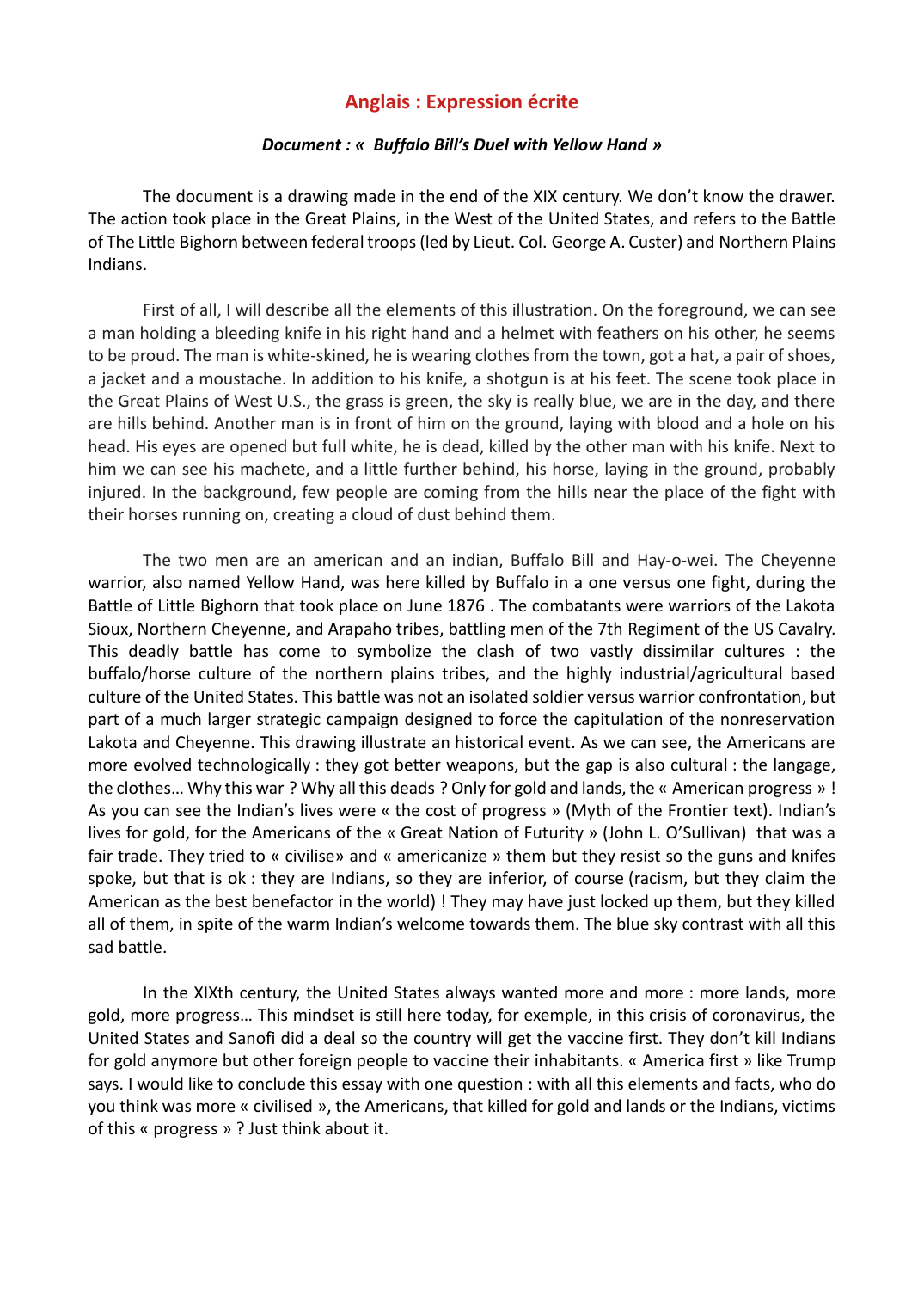Anglais : Expression écrite Document : « Buffalo Bill’s Duel with Yellow Hand »
Publié le 30/08/2021

Extrait du document
«
Anglais : Expression écrite
Document : « Buffalo Bill’s Duel with Yellow Hand »
The document is a drawing made in the end of the XIX century.
We don’t know the drawer.
The action took place in the Great Plains, in the West of the United States, and refers to the Battle
of The Little Bighorn between federal troops (led by Lieut.
Col. George A.
Custer) and Northern Plains
Indians.
First of all, I will describe all the elements of this illustration.
On the f oreground, we can see
a man holding a bleeding knife in his right hand and a helmet with feathers on his other, he seems
to be proud.
The man is white -skined, he is wearing clothes from the town, got a hat, a pair of shoes,
a jacket and a moustache.
In addition to his knife, a sh otgun is at his feet.
The scene took place in
the Great Plains of West U.S., the grass is green, the sky is really blue, we are in the day, and there
are hills behind.
Another man is in front of him on the ground, laying with blood and a hole on his
head.
His eyes are opened but full white, he is dead, killed by the other man with his knife.
Next to
him we can see his machete, and a little further behind, his horse, laying in the ground, probably
injured.
In the background, few people are coming from the hi lls near the place of the fight with
their horses running on, creating a cloud of dust behind them.
The two men are an american and an indian, Buffalo Bill and Hay -o-wei.
The Cheyenne
warrior, also named Yellow Hand, was here killed by Buffalo in a one v ersus one fight, during the
Battle of Little Bighorn that took place on June 1876 .
The combatants were warriors of the Lakota
Sioux, Northern Cheyenne, and Arapaho tribes, battling men of the 7th Regiment of the US Cavalry.
This deadly battle has come to symbolize the clash of two vastly dissimilar cultures : the
buffalo/horse culture of the northern plains tribes, and the highly industrial/agricultural based
culture of the United States.
This battle was not an isolated soldier versus warrior confrontation , but
part of a much larger strategic campaign designed to force the capitulation of the nonreservation
Lakota and Cheyenne.
This drawing illustrate an historical event.
As we can see, the Americans are
more evolved technologically : they got better weapon s, but the gap is also cultural : the langage,
the clothes… Why this war ? Why all this deads ? Only for gold and lands, the « American progress » !
As you can see the Indian’s lives were « the cost of progress » (Myth of the Frontier text).
Indian’s
lives for gold, for the Americans of the « Great Nation of Futurity » (John L.
O’Sullivan) that was a
fair trade.
They tried to « civilise» and « americanize » them but they resist so the guns and knifes
spoke, but that is ok : they are Indians, so they are in ferior, of course (racism, but they claim the
American as the best benefactor in the world) ! They may have just locked up them, but they killed
all of them, in spite of the warm Indian’s welcome towards them.
The blue sky contrast with all this
sad battle .
In the XIXth century, the United States always wanted more and more : more lands, more
gold, more progress… This mindset is still here today, for exemple, in this crisis of coronavirus, the
United States and Sanofi did a deal so the country will get th e vaccine first.
They don’t kill Indians
for gold anymore but other foreign people to vaccine their inhabitants.
« America first » like Trump
says.
I would like to conclude this essay with one question : with all this elements and facts, who do
you think w as more « civilised », the Americans, that killed for gold and lands or the Indians, victims
of this « progress » ? Just think about it..
»
↓↓↓ APERÇU DU DOCUMENT ↓↓↓
Liens utiles
- Mythes et héros : expression écrite (Anglais)
- Espaces et échanges : expression écrite (Anglais)
- Lieux et formes de pouvoir : expression écrite (Anglais)
- L'idée de progrès : expression écrite (Anglais)
- Expression écrite


